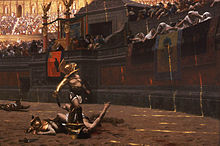- Murmillo
-
The murmillo (also sometimes spelled mirmillo or myrmillo, pl. murmillones) was a type of gladiator during the Roman Imperial age. The murmillo-class gladiator was adopted in the early Imperial period to replace the earlier Gallus, named after the warriors of Gaul. As the Gauls inhabiting Italy had become well-integrated with the Romans by the time of the reign of Augustus, it became undesirable to portray them as enemy outsiders;[dubious ] the Gallus-class gladiator thus had to be retired.[1]
The distinguishing feature of the murmillo was the high crest of his helmet which, together with its broad rim, was shaped somewhat like a fish. The murmillo took his name from this fish-shaped helmet; the word comes from murma, a Greek word for a type of saltwater fish.[2] Otherwise, he wore a loincloth (subligaculum), belt (cintus), very thick wrappings on the lower part of his left leg (designed to protect the top of his feet from attack and from his own shield), a gaiter on his right leg, a linen arm guard (manica) to protect his right arm, and the curved rectangular shield (scutum) of the Roman legionary. He also carried the legionary's short, straight-blade sword, or gladius, from which gladiators derived their name.[2]
The murmillo usually fought the thraex or hoplomachus, with whom he shared some of the equipment (notably arm guards and all-enclosing helmet, and the dangerous short sword). A number of ancient authors, including Valerius Maximus and Quintillian, assert that he also regularly fought the retiarius. It would certainly have been an unusual pairing, contrasting a slow but heavily armoured gladiator with a fast but lightly equipped one. However, this pairing is disputed; visual depictions of murmillones show them fighting the thraex or hoplomachus rather than the retiarius.[2]
Examples of the pairing between murmillones and other gladiator types can be seen in frescoes and graffiti in Pompeii. In one well-preserved example, a murmillo named Marcus Atillus, who is credited with one match and one victory, is depicted standing over the defeated figure of Lucius Raecius Felix, a gladiator with 12 matches and 12 victories. His opponent is shown kneeling, disarmed and unhelmeted. The graffito records that Felix survived the fight and was granted his freedom (manumission).[2]
See Also
References
- ^ Wiedemann, Thomas E. J. Emperors and Gladiators, p. 41. Routledge, 1992. ISBN 041500005X
- ^ a b c d Futrell, Alison. The Roman Games: A Sourcebook, p. 96-100. Blackwell Publishing, 2006. ISBN 1405115688
External links
- James Grout: Murmillo, part of the Encyclopædia Romana
Categories:- Gladiator types
Wikimedia Foundation. 2010.


